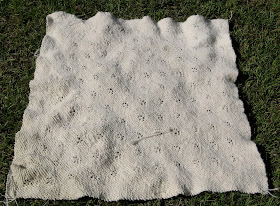My hap shawl that I am knitting from my Shetland handspun is not finished; I was hoping that it would be done last weekend. Here's the tale:
Being the impulsive that I am, I just launched in and did not correctly calculate the ratio of stitches to pick up on the edges, and did a 1 stitch to 2 row ratio. HELLO?? I completed the WHOLE blasted thing including binding off, and the middle sagged like crazy.
Being the impulsive that I am, I just launched in and did not correctly calculate the ratio of stitches to pick up on the edges, and did a 1 stitch to 2 row ratio. HELLO?? I completed the WHOLE blasted thing including binding off, and the middle sagged like crazy.
So, I want back and consulted Sharon Miller's book, then frogged the 6 inch wide fan and feather lace border that I had so enthusiastically completed over the last 2 weeks. Turns out I needed to pickup 5 stitches for every 8 rows; one in each facing stitch plus an extra after every 4th. I proceeded to do this, then happily knit two rows, and discovered a mistake in my fan and feather. SO, frogged a second time; not completely but a good ways back.
I am really hoping that this will be a lovely family heirloom, so I want to get it right! More to follow...
This is what I'd be looking at if I could if could this weekend:
SWEA is the Swedish Women's Educational Association and every year on the first weekend in December they hold their annual holiday fair at the cyclorama in Boston. Here is the info at the SWEA Boston website.
I took my boys there when they were small. B recalls getting Will Farrell's autograph one year (his wife is Swedish).
It's an absolute blast, well...for me anyway, with
Lucia procession, Swedish crafts, food including those cute little heart shaped waffles made fresh with jam and whipped cream (boys were bribed with that), a number of folks sporting handknits in the Scandinavian tradition, and of course, the Scandinavian Airlines System (SAS) table, to help you plan your next trip!
If you are in the Boston area, don't miss it! Since, I'm not going, perhaps I'll complete my hap shawl instead...not to mention my holiday UFO's...













































